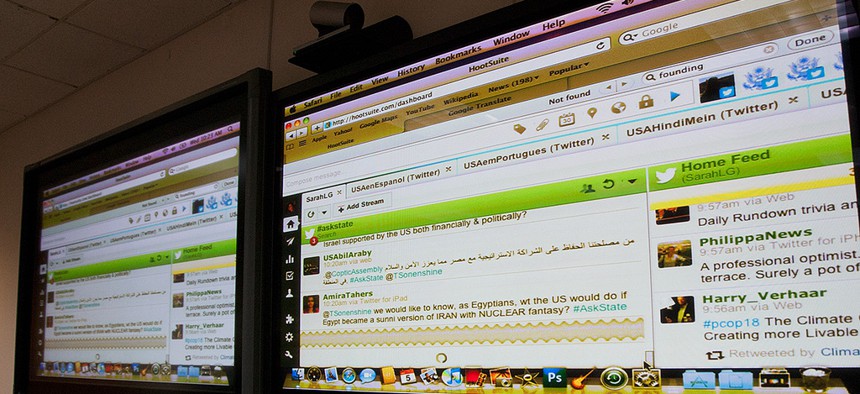
The State Department's Twitter feeds during a global Twitter chat with former undersecretary of state for public diplomacy Tara Sonenshine State Department
How Social Media Affects Diplomacy
Social media blurs the lines between traditional diplomacy and 'public diplomacy.' By Joseph Marks
One effect of the boom in online social activity in recent years has been a blurring of the lines between traditional diplomacy conducted by government officials behind closed doors and the realm of “public diplomacy” where diplomats reach out directly to citizens of another nation, State Department officials said on Tuesday.
“It is just beyond imagination that you can walk out of your door, turn on your computer, pick up a newspaper and not think we’re in a new era of public engagement and public empowerment that has a material impact on traditional diplomacy,” Macon Phillips, the department’s coordinator for international information programs and former White House director of digital strategy said.
Phillips was speaking during a panel discussion at Social Media Week in New York City.
“Private conversations are a heck of a lot easier when there’s a public space for leaders to make difficult decision and that public space is absolutely impacted by public diplomacy,” Phillips said.
The State Department has roughly 800,000 followers on Twitter and 480,000 followers on Facebook. Numerous senior diplomats also have social media accounts, including Secretary of State John Kerry, who is the first head of the department to officially tweet while in office.
Here are some lessons the department has learned from its work in social media:
It’s good to engage on a personal level
Personal tweets and Facebook posts from ambassadors and other high ranking officials can show a human side to policy that’s more difficult to convey through official profiles, panelists said. That’s a difficult line to tread at the State Department, however, which aims to speak with a single voice about international questions.
Earlier this month, Secretary Kerry began tweeting again from the personal account he used as a U.S. senator. During his first year in office, Kerry occasionally tweeted from the official State Department account and signed the tweets with his initials “JK.”
Kerry also posted an #unselfie photo in November, urging followers to donate money to Typhoon victims in the Philippines, which helped increase donations. The #unselfie is a play on #selfie photos in which people hide their faces behind a piece of paper with text or a Web address that advocates for a cause.
(In Kerry’s case, the digital team made sure the legal pad that carried a Web address for Typhoon donations left “the very distinctive John Kerry hair” uncovered so people would be sure to recognize him, said Doug Frantz, assistant secretary of state for public affairs).
But that personal touch can be risky
The personalization and the speed of social media engagement also means the State Department must be more tolerant of the minor errors or poorly formed thoughts that come out when people speak off the cuff rather than in official statements, Frantz said.
“Social media is an interactive platform so if you wait to come back to the State Department to get clearance on how to respond to a question over twitter it will take days if not weeks and the conversation will be over,” Frantz said. “So you want people to be engaged. You want them to be willing and able to take responsible risks…Don’t take a big crazy risk and try to change our policy on Iran, but if you’re behaving responsibly, we can expect small mistakes.”
In many ways, the department is vulnerable to those risks whether or not officials are actively engaging on social media.
Frantz cited the case of a diplomatic security officer and his wife who were expelled from India after making derogatory comments about the country on their personal Facebook pages. “I tell people never tweet anything you don’t want to see on the front page of the Washington Post,” Frantz said.
NEXT STORY: The End of the New ICBM





